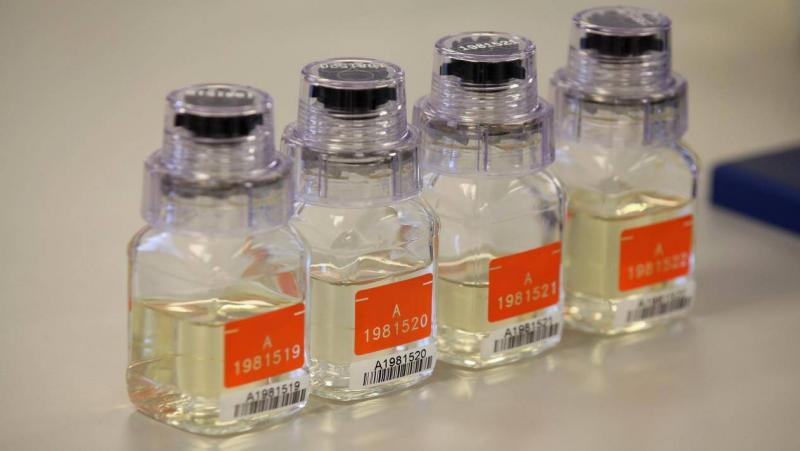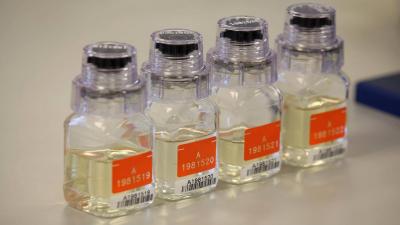The normal color range of human urine (or what is known as healthy urine colors) varies from pale yellow to dark amber, due to the presence of a pigment called urochrome and the dilution or concentration of the urine. Additionally, pigments and other compounds found in certain foods and medications can alter the urine's color. Foods such as beets, berries, and fava beans are among the most common that affect urine color. Some over-the-counter medications, like some vitamins, and certain prescribed medications, such as antibiotics, also produce bright colors like raspberry red, lemon yellow, and orange. Abnormal urine color is one of the most common signs of a bacterial infection in the urinary tract, and dark purple urine indicates characteristics of porphyria, a rare inherited disorder of red blood cells. Normal urine color varies depending on how much water you consume, as fluids dilute the concentration of yellow pigments in urine. Hence, the more water you drink, the clearer the urine appears. Conversely, when consuming less water, the color becomes more concentrated, and severe dehydration may result in the urine appearing amber. However, urine can sometimes turn into abnormal colors such as red, blue, green, dark brown, and cloudy white.
### Urine Color and What It Indicates
There is frequent inquiry into urine color changes, their causes, and significance in various forms, including: what causes dark urine? What causes green urine? Why is a child's urine dark like tea? What causes red urine? What are the reasons for dark urine? The potential causes of orange urine in the morning, or why urine is red? Additionally, there is interest in dark-colored urine, the reasons for brown urine, yellow urine, and whether dark urine is concerning, amber urine, or the cause of green urine, and the difference between white and yellow urine. It is noted that changes in urine color to specific colors may require consulting a physician.
### Presence of Blood in Urine
The presence of blood in urine (hematuria) is common in urinary tract infections and kidney stones, typically resulting in pain, while painless bleeding may indicate more serious issues, such as cancer.
### Dark Brown Urine
If urine is dark brown, especially accompanied by pale-colored stool and yellowing of the skin and eyes (jaundice), this may indicate a liver disease.
### Red or Pink Urine Discoloration
Despite its alarming appearance, red urine is not necessarily dangerous and can result from:
- **Blood:** Factors causing blood in urine (hematuria) include urinary tract infections, prostate enlargement, both benign and malignant tumors, kidney cysts, long-distance running, kidney stones, and bladder issues.
- **Certain Foods:** Beets, blackberries, and rhubarb can change urine color to red or pink.
- **Medications:** Rifampin (Rifadin, Rimactane), commonly used to treat tuberculosis, can turn urine red, as can phenazopyridine (Pyridium), a pain reliever for urinary tract discomfort.
- **Poisoning:** Chronic poisoning with lead or mercury may also cause the urine to turn red.
### Orange Urine
In the case of orange urine, attention should be given to the following causes:
- **Medications:** Drugs like rifampin, sulfasalazine (Azulfidine), phenazopyridine (Pyridium), some laxatives, and certain chemotherapy agents can change urine to orange.
- **Medical Conditions:** In some cases, orange urine may indicate liver or bile duct issues, especially if accompanied by light-colored stool. Dehydration can also concentrate urine, resulting in a darker shade.
### Blue or Green Urine
Blue or green urine may result from:
- **Dyes:** Some food colorings can alter urine color to green, and some dyes used in kidney and bladder function tests can change urine to blue.
- **Medications:** Certain drugs including amitriptyline, indomethacin (Indocin), and propofol (Diprivan) may lead to blue or green urine.
- **Medical Conditions:** Familial hypocalcemia, a rare inherited disorder, is sometimes called "blue diaper syndrome" due to blue urine in affected infants. Green urine can also appear during urinary tract infections caused by specific bacteria, such as Pseudomonas (blue pus bacillus).
### Dark Brown or Tea-Colored Urine
- **Foods:** Large quantities of fava beans, rhubarb, or aloe may darken urine color.
- **Medications:** Many drugs, including antimalarials like chloroquine and primaquine, antibiotics like metronidazole and nitrofurantoin, certain laxatives containing cascara or senna, and methocarbamol (a muscle relaxant) can darken urine.
- **Medical Conditions:** Certain liver and kidney disorders may lead to dark brown urine, as can some urinary tract infections.
### Cloudy or Murky Urine
Urinary tract infections and kidney stones can lead to cloudy or murky urine.
### Factors Making You Prone to Conditions Affecting Urine Color
- **Age:** Bladder and kidney tumors leading to blood in urine are more common in older adults. Blood is often found in the urine during asymptomatic episodes in individuals over 50 with prostate enlargement or bladder or kidney cancer.
- **Gender:** More than half of women will experience a urinary tract infection at some point in their lives, often with blood in urine. Men are more likely to develop kidney stones.
- **Family Medical History:** A family history of kidney disease or stones increases the likelihood of these issues, which may lead to blood in urine.
- **Strenuous Exercise:** Long-distance runners are more susceptible to blood in the urine, although it can occur in anyone engaging in strenuous exercise.
### Diagnostic Tests
Doctors may recommend the following diagnostic tests:
- **Urinalysis:** A comprehensive urinalysis is the first important step used to search for red blood cells and high protein levels, which may indicate kidney issues, as well as minerals excreted that could lead to kidney stones. A urine sample will likely be checked for bacteria causing urinary infections.
- **Blood Tests:** These tests can measure blood creatinine and blood urea nitrogen levels, which accumulate in the bloodstream when the kidneys fail to filter properly. Blood tests may also reveal elevated bilirubin levels and liver enzymes, as well as conditions like diabetes.
Finally, there is no specific treatment for changes in urine color. Instead, the physician will focus on diagnosing the underlying reason for the change and addressing any underlying medical issues. It is also essential to emphasize adequate fluid intake daily to maintain hydration and health.




